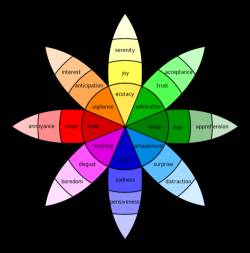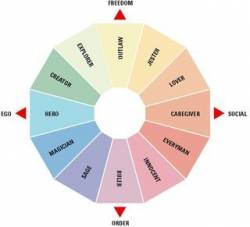|
Resources
Sites in section: 4
Shown sites: 1-4 |
|
Image & Text
 Robert Plutchik created a wheel of emotions in 1980 which consisted of 8 basic emotions and 8 advanced emotions each composed of 2 basic ones. Eight Basic Emotions - Joy
- Sadness
- Trust
- Disgust
- Fear
- Anger
- Surprise
- Anticipation
Basic Emotion ⇄ Basic Opposite - Joy ⇄ Sadness
- Trust ⇄ Disgust
- Fear ⇄ Anger
- Surprise ⇄ Anticipation
Combination of Basic Emotions (A + B) = Advanced Human Emotions (Opposite Advanced Emotion in Parentheses) - Anticipation + Joy = Optimism (Disapproval)
- Joy + Trust = Love (Remorse)
- Trust + Fear = Submission (Contempt)
- Fear + Surprise = Awe (Aggression)
- Surprise + Sadness = Disappointment (Optimism)
- Sadness + Disgust = Remorse (Love)
- Disgust + Anger = Contempt (Submission)
- Anger + Anticipation = Aggression (Awe)
|
Text Only
- Name: At least first and last. If your character has an alias, you may want to include that as well.
- Gender: This could be anything, really. Most authors stick to male and female, but gender is a heck-of-a-lot more complicated than that. For more on gender, check out what is your gender identity? by kerryg over on HubPages.
- Sexual Orientation: The importance of sexual orientation changes depending on the story you wish to tell. For instance, a character’s sexual orientation is extremely important in a Romance novel, but less so in an Action/Adventure story where no love interest is ever introduced.
- Age: You can fudge here by saying something like, "Fergus is in his early fifties” or "Jan had recently had her sixth 29th birthday in a row”. Age may change how relatable a character is to your readers and drive how they deal with the world. Make sure to include it.
- Class/Status: A character’s class or status will determine a lot of things about him or her, especially the way he or she feels about money and his or her customs, traditions, privilege, and treatment of other socioeconomic classes.
- Physical Description: Be sure to include things like skin, hair, and eye color. Mention scars or tattoos, piercings, clothing choice, height, weight, and overall physical attractiveness. If they are from a particular region with identifying characteristics, you may want to relay those as well.
- Quirks: Does he or she have a personal item that is always with him or her? Does your character have a nervous tick or else collect model trains? We have a whole list of quirks on our character quirks page, including habits, phobias, hobbies, diseases, and addictions. Quirks make characters more rounded and are outward displays of their personality.
- Morality: A character’s morality often describes their role in a story. Lose morals may signal that the character is an antagonist, while right-mindedness is more of a protagonist trait. Signaling a character’s morality may be as simple as outright stating, "My character is moral” or giving an example like, "James would jump in front of a subway train to save a baby”. An article about morality can be found on our page is my character moral? which may help you make decisions about your character’s morality.
- Personality Strengths/Weaknesses: We call these Virtues and Vices, and you can read all about what we think about them on our character virtues and vices page. This is one of the more important things about a character to get right. Personality will determine whether or not a character is relatable to the reader on a much grander scale than age or gender ever could, and it is vital for characters to be multifaceted. For example, a character concerned with Justice (one of the Seven High Virtues) may also be stubborn and a bit outspoken. It is important to note the strengths and the weaknesses here, as no character is ever wholly good or evil.
- Skills: Basically, what is you character good at? Does he or she have any learned or inherent skills (like carpentry, firewood gathering, or magical ability) that separate him or her from the crowd? Even if many characters in your story have similar skills, make sure to describe how this character’s skillset differs from everyone else’s.
- Education: Education does not necessarily mean intelligence (intellect is a strength), but the kind of education, where the character got it, and why is often important to the story. For example, language plays an important role in a story with dialogue, as the character must speak and be understood. The language the character uses, whether he or she has a broad vocabulary or even if he or she is able to speak the same language as other characters, all derives from the education he or she received. Class may play a part in education, and a character’s skills will certainly be affected by his or her education.
- Likes/Dislikes: This is everything from how the character takes his or her tea to any prejudices he or she has. Where does he or she like to go? What does your character like to do? What sort of people does he or she prefer? Like and dislikes are heavily driven by everything else on this list. Keep the rest of your character’s bio in mind as you write about their likes and dislikes.
- Childhood/Backstory: Where is your character from? What language does he or she speak? What sort of parents does he or she have? What was his or her childhood like? Anything that got your character from birth to the beginning of the story is backstory, and you can toss in some family or cultural history as well.
- Profession: What does your character do to earn a living? If he or she does not work, address this. A character’s profession takes up most of their adult life, so it’s important that the reader knows what they do and how seriously they take it.
- Relationships: Relationships are complicated. Talk about your character’s relationship to anyone they come into contact with regularly and who has a large impact on their life at the beginning of the story. Ideally, you should mention someone your character gets along with and someone he or she definitely doesn’t get along with. Also, it’s a good idea to mention any romantic interests he or she has at the beginning of the story, his or her relationship with immediate family, and how he or she does with being alone and in crowds of strangers (this ties in with strengths and weaknesses).
- Location: Where is the character? If he or she was born there, mention this ("Lily had never been out of Toronto”). Is he or she starting out in a new place? The location of the character often tells the reader the location of the story. Don’t overlook this. Even if he or she starts out blindfolded in an undisclosed location, the character is still in a location.
- Time Period: When does this person live? Time period and location are technically setting, but they weigh heavily on a character, so be sure to include them.
- Religious Beliefs: Whether or not a character’s religious beliefs play a huge part in the story, it’s often good to know what they feel about God(s) in their world. We’d also categorize superstitions under religious beliefs, even though these are usually defined as quirks (see above). If your character’s beliefs aren’t important to the story, feel free to omit them from the description; if they are, don’t forget to mention them!
- Fantastical Traits: Is this character magical? Can he or she time travel or do anything that normal human beings are scientifically incapable of doing? If we know at the onset (or it’s not a huge spoiler to mention) that your character is fantastical in some way, tell us! Like skills and quirks, fantastical traits set your character apart.
- Goals: This item is last, but it should really be first. More important even than a name, a character’s goals drive the plot. You should make at least one of his or her goals clear in your bio.
|
|
Hi, my name is Annie and this is where I catalog useful art resources and tutorials I stumble upon. You're welcome to use this site, too! Disclaimer: I don't claim any of the resources or tutorials on this site, they are only for educational purposes.
Art Tumblr: theanniehsu
|

